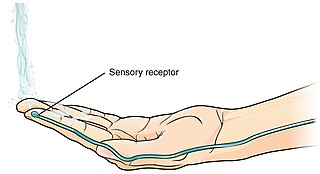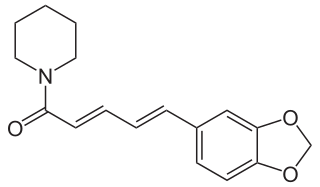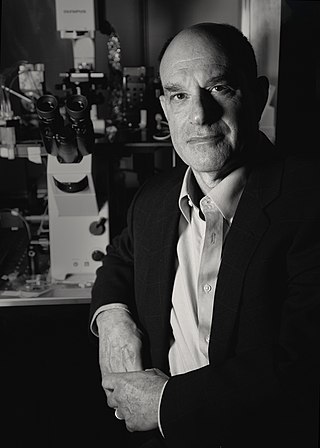Related Research Articles

A thermoreceptor is a non-specialised sense receptor, or more accurately the receptive portion of a sensory neuron, that codes absolute and relative changes in temperature, primarily within the innocuous range. In the mammalian peripheral nervous system, warmth receptors are thought to be unmyelinated C-fibres, while those responding to cold have both C-fibers and thinly myelinated A delta fibers. The adequate stimulus for a warm receptor is warming, which results in an increase in their action potential discharge rate. Cooling results in a decrease in warm receptor discharge rate. For cold receptors their firing rate increases during cooling and decreases during warming. Some cold receptors also respond with a brief action potential discharge to high temperatures, i.e. typically above 45 °C, and this is known as a paradoxical response to heat. The mechanism responsible for this behavior has not been determined.
Transient receptor potential channels are a group of ion channels located mostly on the plasma membrane of numerous animal cell types. Most of these are grouped into two broad groups: Group 1 includes TRPC, TRPV, TRPVL, TRPM, TRPS, TRPN, and TRPA. Group 2 consists of TRPP and TRPML. Other less-well categorized TRP channels exist, including yeast channels and a number of Group 1 and Group 2 channels present in non-animals. Many of these channels mediate a variety of sensations such as pain, temperature, different kinds of tastes, pressure, and vision. In the body, some TRP channels are thought to behave like microscopic thermometers and used in animals to sense hot or cold. Some TRP channels are activated by molecules found in spices like garlic (allicin), chili pepper (capsaicin), wasabi ; others are activated by menthol, camphor, peppermint, and cooling agents; yet others are activated by molecules found in cannabis or stevia. Some act as sensors of osmotic pressure, volume, stretch, and vibration. Most of the channels are activated or inhibited by signaling lipids and contribute to a family of lipid-gated ion channels.

Piperine, possibly along with its isomer chavicine, is the compound responsible for the pungency of black pepper and long pepper. It has been used in some forms of traditional medicine.
Calcium release-activated channels (CRAC) are specialized plasma membrane Ca2+ ion channels. When calcium ions (Ca2+) are depleted from the endoplasmic reticulum (a major store of Ca2+) of mammalian cells, the CRAC channel is activated to slowly replenish the level of calcium in the endoplasmic reticulum. The Ca2+ Release-activated Ca2+ (CRAC) Channel (CRAC-C) Family (TC# 1.A.52) is a member of the Cation Diffusion Facilitator (CDF) Superfamily. These proteins typically have between 4 and 6 transmembrane α-helical spanners (TMSs). The 4 TMS CRAC channels arose by loss of 2TMSs from 6TMS CDF carriers, an example of 'reverse' evolution'.

Allyl isothiocyanate (AITC) is a naturally occurring unsaturated isothiocyanate. The colorless oil is responsible for the pungent taste of Cruciferous vegetables such as mustard, radish, horseradish, and wasabi. This pungency and the lachrymatory effect of AITC are mediated through the TRPA1 and TRPV1 ion channels. It is slightly soluble in water, but more soluble in most organic solvents.

Diallyl disulfide is an organosulfur compound derived from garlic and a few other genus Allium plants. Along with diallyl trisulfide and diallyl tetrasulfide, it is one of the principal components of the distilled oil of garlic. It is a yellowish liquid which is insoluble in water and has a strong garlic odor. It is produced during the decomposition of allicin, which is released upon crushing garlic and other plants of the family Alliaceae. Diallyl disulfide has many of the health benefits of garlic, but it is also an allergen causing garlic allergy. Highly diluted, it is used as a flavoring in food. It decomposes in the human body into other compounds such as allyl methyl sulfide.

The inorganic dye ammoniated ruthenium oxychloride, also known as ruthenium red, is used in histology to stain aldehyde fixed mucopolysaccharides.

The transient receptor potential cation channel subfamily V member 1 (TRPV1), also known as the capsaicin receptor and the vanilloid receptor 1, is a protein that, in humans, is encoded by the TRPV1 gene. It was the first isolated member of the transient receptor potential vanilloid receptor proteins that in turn are a sub-family of the transient receptor potential protein group. This protein is a member of the TRPV group of transient receptor potential family of ion channels. And a receptor being clearly present in bacteria, the oldest organisms on Earth known to express phosphatidylethanolamine, the precursor to endocannabinoids, in their cytoplasmic membranes, and fatty acid metabolites with affinity for this CB receptor are produced by cyanobacteria, which diverged from eukaryotes at least 2000 million years ago (MYA).

Capsazepine is a synthetic antagonist of capsaicin. It is used as a biochemical tool in the study of TRPV ion channels.

TRPA is a family of transient receptor potential ion channels. The TRPA family is made up of 7 subfamilies: TRPA1, TRPA- or TRPA1-like, TRPA5, painless, pyrexia, waterwitch, and HsTRPA. TRPA1 is the only subfamily widely expressed across animals, while the other subfamilies are largely absent in deuterostomes.

Transient receptor potential cation channel, subfamily A, member 1, also known as transient receptor potential ankyrin 1, TRPA1, or The Wasabi Receptor, is a protein that in humans is encoded by the TRPA1 gene.

Transient receptor potential cation channel subfamily M (melastatin) member 8 (TRPM8), also known as the cold and menthol receptor 1 (CMR1), is a protein that in humans is encoded by the TRPM8 gene. The TRPM8 channel is the primary molecular transducer of cold somatosensation in humans. In addition, mints can desensitize a region through the activation of TRPM8 receptors.

Hydroxy-alpha-sanshool is a molecule found in plants from the genus Zanthoxylum. It is believed to be responsible for the numbing and tingling sensation caused by eating food cooked with Sichuan peppercorns and Uzazi.

Pungency refers to the taste of food commonly referred to as spiciness, hotness or heat, found in foods such as chili peppers. Highly pungent tastes may be experienced as unpleasant. The term piquancy is sometimes applied to foods with a lower degree of pungency that are "agreeably stimulating to the palate". Examples of piquant food include mustard and curry.

David Jay Julius is an American physiologist and Nobel Prize laureate known for his work on molecular mechanisms of pain sensation and heat, including the characterization of the TRPV1 and TRPM8 receptors that detect capsaicin, menthol, and temperature. He is a professor at the University of California, San Francisco.

PF-4840154 is a pyrimidine derivative discovered by Pfizer at its Sandwich, Kent research center. The compound is a potent, selective activator of both the human (EC50 = 23 nM) and rat (EC50 = 97 nM) TRPA1 channels. This compound elicits nociception in a mouse model through TRPA1 activation. PF-4840154 is used as a reference agonist of the TRPA1 channel for in-vitro high-throughput screening purposes, and is superior to allyl isothiocyanate for this use. The TRPA1 channel is considered an attractive pain target based on the fact that TRPA1 knockout mice showed near complete attenuation of pain behaviors in some pre-clinical development models.

Umbellulone is a headache-inducing monoterpene ketone found in the leaves of the tree Umbellularia californica, sometimes known as the "headache tree".

Antifeedants are organic compounds produced by plants to repel herbivores through distaste or toxicity. These chemical compounds are typically classified as secondary metabolites in that they are not essential for the metabolism of the plant, but instead confer longevity. Antifeedants exhibit a wide range of activities and chemical structures as biopesticides. Examples include rosin, which inhibits attack on trees, and many alkaloids, which are highly toxic to specific insect species.

Wasabi receptor toxin (WaTx) is the active component of the venom of the Australian black rock scorpion Urodacus manicatus. WaTx targets TRPA1, also known as the wasabi receptor or irritant receptor. WaTx is a cell-penetrating toxin that stabilizes the TRPA1 channel open state while reducing its Ca2+-permeability, thereby eliciting pain and pain hypersensitivity without the neurogenic inflammation that typically occurs in other animal toxins.

WS-12 is a chemical compound that acts as a potent and selective activator of the TRPM8 calcium channel, which is responsible for the sensation of coldness produced by menthol. It is slightly less potent as a TRPM8 activator compared to icilin, but is much more selective for TRPM8 over related calcium channels. It produces analgesic and antiinflammatory effects in animal models with similar efficacy to menthol and a reduced side effect profile.
References
- ↑ Bautista, Diana M.; Hoth, Markus; Lewis, Richard S. (June 2002). "Enhancement of calcium signalling dynamics and stability by delayed modulation of the plasma-membrane calcium-ATPase in human T cells". The Journal of Physiology. 541 (3): 877–894. doi:10.1113/jphysiol.2001.016154. PMC 2290354 . PMID 12068047.
- ↑ Bautista, Diana M.; Lewis, Richard S. (May 2004). "Modulation of plasma membrane calcium-ATPase activity by local calcium microdomains near CRAC channels in human T cells: Local coupling of Ca 2+ pumps and CRAC channels". The Journal of Physiology. 556 (3): 805–817. doi:10.1113/jphysiol.2003.060004. PMC 1665005 . PMID 14966303.
- ↑ Bautista, D. M.; Movahed, P.; Hinman, A.; Axelsson, H. E.; Sterner, O.; Hogestatt, E. D.; Julius, D.; Jordt, S.-E.; Zygmunt, P. M. (2005-08-23). "Pungent products from garlic activate the sensory ion channel TRPA1". Proceedings of the National Academy of Sciences. 102 (34): 12248–12252. Bibcode:2005PNAS..10212248B. doi: 10.1073/pnas.0505356102 . ISSN 0027-8424. PMC 1189336 . PMID 16103371.
- 1 2 3 Bautista, Diana M.; Jordt, Sven-Eric; Nikai, Tetsuro; Tsuruda, Pamela R.; Read, Andrew J.; Poblete, Jeannie; Yamoah, Ebenezer N.; Basbaum, Allan I.; Julius, David (March 2006). "TRPA1 Mediates the Inflammatory Actions of Environmental Irritants and Proalgesic Agents". Cell. 124 (6): 1269–1282. doi: 10.1016/j.cell.2006.02.023 . PMID 16564016. S2CID 11666291.
- 1 2 Bautista, Diana M.; Siemens, Jan; Glazer, Joshua M.; Tsuruda, Pamela R.; Basbaum, Allan I.; Stucky, Cheryl L.; Jordt, Sven-Eric; Julius, David (July 2007). "The menthol receptor TRPM8 is the principal detector of environmental cold". Nature. 448 (7150): 204–208. Bibcode:2007Natur.448..204B. doi:10.1038/nature05910. ISSN 0028-0836. PMID 17538622. S2CID 4427901.
- ↑ Bautista, Diana M; Sigal, Yaron M; Milstein, Aaron D; Garrison, Jennifer L; Zorn, Julie A; Tsuruda, Pamela R; Nicoll, Roger A; Julius, David (July 2008). "Pungent agents from Szechuan peppers excite sensory neurons by inhibiting two-pore potassium channels". Nature Neuroscience. 11 (7): 772–779. doi:10.1038/nn.2143. ISSN 1097-6256. PMC 3072296 . PMID 18568022.
- ↑ Jordt, Sven-Eric; Bautista, Diana M.; Chuang, Huai-hu; McKemy, David D.; Zygmunt, Peter M.; Högestätt, Edward D.; Meng, Ian D.; Julius, David (January 2004). "Mustard oils and cannabinoids excite sensory nerve fibres through the TRP channel ANKTM1". Nature. 427 (6971): 260–265. Bibcode:2004Natur.427..260J. doi:10.1038/nature02282. ISSN 0028-0836. PMID 14712238. S2CID 4354737.
- 1 2 3 4 5 6 7 8 9 10 Office, FENS. "Diana Bautisa". FENS.org. Retrieved 2020-03-07.